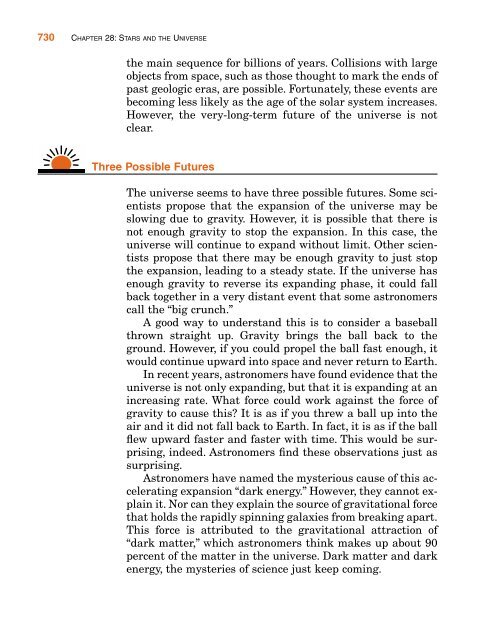Chapter 28 Stars and the Universe
Chapter 28 Stars and the Universe
Chapter 28 Stars and the Universe
You also want an ePaper? Increase the reach of your titles
YUMPU automatically turns print PDFs into web optimized ePapers that Google loves.
730 CHAPTER <strong>28</strong>: STARS AND THE UNIVERSE<br />
<strong>the</strong> main sequence for billions of years. Collisions with large<br />
objects from space, such as those thought to mark <strong>the</strong> ends of<br />
past geologic eras, are possible. Fortunately, <strong>the</strong>se events are<br />
becoming less likely as <strong>the</strong> age of <strong>the</strong> solar system increases.<br />
However, <strong>the</strong> very-long-term future of <strong>the</strong> universe is not<br />
clear.<br />
Three Possible Futures<br />
The universe seems to have three possible futures. Some scientists<br />
propose that <strong>the</strong> expansion of <strong>the</strong> universe may be<br />
slowing due to gravity. However, it is possible that <strong>the</strong>re is<br />
not enough gravity to stop <strong>the</strong> expansion. In this case, <strong>the</strong><br />
universe will continue to exp<strong>and</strong> without limit. O<strong>the</strong>r scientists<br />
propose that <strong>the</strong>re may be enough gravity to just stop<br />
<strong>the</strong> expansion, leading to a steady state. If <strong>the</strong> universe has<br />
enough gravity to reverse its exp<strong>and</strong>ing phase, it could fall<br />
back toge<strong>the</strong>r in a very distant event that some astronomers<br />
call <strong>the</strong> “big crunch.”<br />
A good way to underst<strong>and</strong> this is to consider a baseball<br />
thrown straight up. Gravity brings <strong>the</strong> ball back to <strong>the</strong><br />
ground. However, if you could propel <strong>the</strong> ball fast enough, it<br />
would continue upward into space <strong>and</strong> never return to Earth.<br />
In recent years, astronomers have found evidence that <strong>the</strong><br />
universe is not only exp<strong>and</strong>ing, but that it is exp<strong>and</strong>ing at an<br />
increasing rate. What force could work against <strong>the</strong> force of<br />
gravity to cause this? It is as if you threw a ball up into <strong>the</strong><br />
air <strong>and</strong> it did not fall back to Earth. In fact, it is as if <strong>the</strong> ball<br />
flew upward faster <strong>and</strong> faster with time. This would be surprising,<br />
indeed. Astronomers find <strong>the</strong>se observations just as<br />
surprising.<br />
Astronomers have named <strong>the</strong> mysterious cause of this accelerating<br />
expansion “dark energy.” However, <strong>the</strong>y cannot explain<br />
it. Nor can <strong>the</strong>y explain <strong>the</strong> source of gravitational force<br />
that holds <strong>the</strong> rapidly spinning galaxies from breaking apart.<br />
This force is attributed to <strong>the</strong> gravitational attraction of<br />
“dark matter,” which astronomers think makes up about 90<br />
percent of <strong>the</strong> matter in <strong>the</strong> universe. Dark matter <strong>and</strong> dark<br />
energy, <strong>the</strong> mysteries of science just keep coming.

















